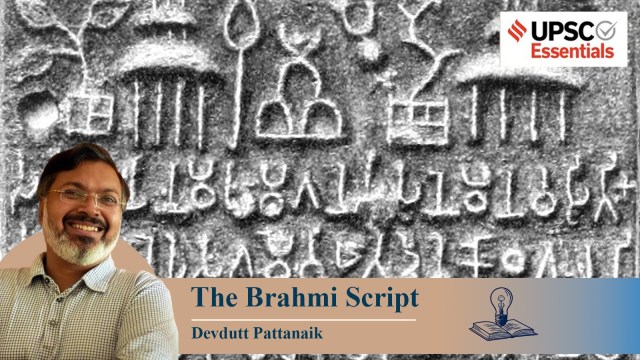© IE Online Media Services Pvt Ltd
Latest Comment
Post Comment
Read Comments
 Soghaura inscription (Source: Wikimedia Commons)
Soghaura inscription (Source: Wikimedia Commons)In Jain myths, Rishabhadeva, the first Tirthankara of this era, passed on the knowledge of writing to his daughter Brahmi and the knowledge of numbers to his daughter Sundari. Literature and mathematics originate from two Jain nuns. Jains saw Vidyas, or subjects, as a group of goddesses that emerge from the teachings of the Tirthankara. However, these stories emerged much later and may have been a poetic way of explaining the origin of writing.
Scholars believe that Jainism played a key role in transmitting scripts. In Tamil Nadu, the Tamil Brahmi script has been found at Jain sites, where there are stone beds, where Jain monks would fast unto death. The script is dated to 270 BC and may be older than the Ashokan scripts, dated to 250 BC. So it is clear that 2,300 years ago, writing had reached many parts of India through the activities of merchants, monks and kings.
Why is the Ashokan script called the Brahmi script? Was it known so in Mauryan times? We do not know. Early scholars referred to it as “pin-man” script, then “Lat” script (from lathi, or staff, as the Ashokan pillars were known), “Indian Pali” and “Mauryan” scripts. What we do know is that in Buddhist stories, composed centuries later, such as the Sanskrit work, Lalitavistara Sutra (300 AD), Prince Siddhartha Gautama learnt many ways of writing. There is a list of scripts given in these stories. The first script was Brahmi and so scholars declared the Ashokan script was Brahmi. It had nothing to do with Brahma or Brahmins.
Brahmi is the mother of most scripts found across Southeast Asia. It spread with Buddhism. It is a unique script, different from the Latin alphabet and the Semitic script. Latin uses consonants and vowels as separate units one after another. This is written from left to right. Semitic scripts are written right to left and have consonants only, not vowels. Brahmi is written left to right and in a very unique circular way. The consonants (akshara) sit in the centre and vowels (matra) can appear as diacritical marks around it: above, below, left or right. Consonants and the vowels are located in concentric circles.
Scripts tell us a lot about Indian culture and the influence Indian culture has had on the world. There was an abugida-syllabary script used in the Gandhara region, during Ashokan times, called Kharosthi. Kharoshti was written right-to-left (indicating Aramaic influence of the Persians) while Brahmi was written left-to-right (indicating independent origin). Over time, Kharoshti lost favour as Brahmi gained prominence.
The Chinese script is logographic. It has numerous characters that are tough to remember. Different Chinese dialects pronounce the same Mandarin character differently, but the words have the same meaning. This unifies the country, hence preferred. Even when Buddhism spread to China, Buddhist mantras were written in the Chinese script.
The Japanese have both a logographic script (kanji), which has 50,000 characters, as well as a syllabary (kana) script, which uses about 50 symbols. This happened 1000 years ago, as they were influenced by Brahmi scripts used in Buddhist texts. In fact, the Japanese use the Siddha script of Eastern India in Buddhist mantras.
The Chinese logographic script used by elite Koreans was too tough to learn. So, 500 years ago, a new script was developed by the Korean king to make the common man literate. His courtiers were inspired by the Tamil script that had evolved from Brahmi. Tamil and Korean have many common words indicating trade relationships. Tamil traders had even built the Kaiyuan Temple in Quanzhou, China, around the 1300s.
The Brahmi script has consonants with vowels around them. The Hangul script of Korea followed the same principle but in its own unique way. Though inspired by the Brahmi abugida script, it was even more simple to learn.
Brahmi scripts have no particular logic. But Hangul script had a clear logic, written in the same way as the tongue is placed in the mouth while pronouncing a consonant and a vowel. This makes it easy to remember. Hangul had different symbols for 15 consonants and 10 syllables. The vowel could be placed either to the right or below the consonant. This made it easy to learn. And it enabled Koreans to be literate very fast.
In India, writing was resisted for a long time. Between 300 BC and 100 AD, all writing was in the Prakrit languages. Only after 400 years did Sanskrit writing begin. Then, Sanskrit became the dominant court language, used in royal proclamations from 300 AD to 1300 AD, from Afghanistan to Vietnam. This came to an end with the rise of Islam. Along with new Arabic and Persian scripts, local Indian scripts emerged for local Indian languages.
Scripts tell us a lot about Indian culture and the influence Indian culture has had on the world. Discuss with reference to the Brahmi Script.
How does the arrangement of vowels in the Brahmi script make it unique?
How is the Brahmi script connected to both Hinduism and Jain mythology? What does Digambar Jain mythology say about Brahmi?
In what ways does Brahmi differ from alphabetic (Latin) and consonantal (Semitic) scripts, and what does this reveal about its uniqueness as an abugida?
(Devdutt Pattanaik is a renowned mythologist who writes on art, culture and heritage.)
Share your thoughts and ideas on UPSC Special articles with ashiya.parveen@indianexpress.com.
Subscribe to our UPSC newsletter and stay updated with the news cues from the past week.
Stay updated with the latest UPSC articles by joining our Telegram channel – IndianExpress UPSC Hub, and follow us on Instagram and X.

Read UPSC Magazine